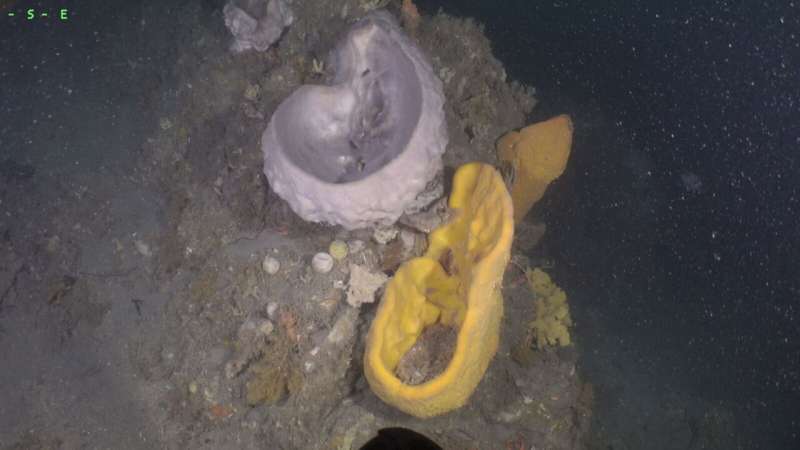Sponges on a deep-water reef off the Kapiti coast. Credit: Victoria University of Wellington
A huge diversity of marine life, including brightly colored sponges, has been found in deep-water reefs off Wellington's south coast and the Kapiti coast.
The discovery was made by researchers from Te Herenga Waka—Victoria University of Wellington who surveyed nine underwater sites in the region using a remotely operated vehicle.
"We really didn't know what to expect when we first sent the vehicle into the water and were genuinely surprised when it got to the sea floor and all these amazing brightly colored sponges came into view," says Professor James Bell, a marine biologist at the University.
"Most of the areas we visited could be described as sponge 'gardens' and they looked very different to any we have seen in other parts of the country. The reefs were also teeming with fish, including blue cod and Jock Stewarts or sea perch."
The diversity of fish and other species indicates the deep-water reefs are important habitats for marine life.
Professor Bell says it's likely the fish are feeding in the reefs and using them for shelter.
"While we found little evidence of human impacts, which we're really pleased about, it does remind us that care needs to be taken when deploying anchors or bottom fishing, as these are clearly important habitats that we need to look after."
Deep-water reefs supporting diverse marine communities have been reported at other locations around New Zealand. However, the reefs off Wellington's coast and the species they support have not been explored until now.
Credit: Victoria University of Wellington
Dr. Alice Rogers, lecturer in fisheries biology at the University, believes deep-water reefs could be important for supporting fish stocks and the future of fisheries.
"These deep reefs support a huge diversity of life and create complex habitats that are likely to be important for many fisheries, providing a source of food for the species targeted. What's more, being in deeper water means these places are potential refuges—safe zones where fish can go during extreme weather or heatwaves that impact the shallows."
The research team surveyed three sites on the Wellington south coast and six on the Kapiti coast, ranging in depth from 26 to 57 meters. Across all sites, sponges, cnidarians, and bryozoans (commonly known as moss animals) were the most abundant species.
Professor Bell says "very little bare space" was found at any of the sites surveyed.
Greater Wellington senior environmental scientist Dr. Megan Oliver says the research has shed light on the mysterious deep waters on the region's doorstep.
"This work goes a long way towards making the hidden marine world more visible. One of the biggest barriers to looking after our marine environment is not knowing what ecosystems we have, or where they are. We can now apply regional planning rules to protect these important habitats and the diverse marine life they support," Dr. Oliver says.
Mathilde Richer de Forges, DOC marine ecosystems manager, says, "Management of deep reefs is hindered by our lack of knowledge, such as where they are found, their links to other ecosystems, and how vulnerable they are to threats. This important research is part of a larger effort to gather information on these little-known ecosystems."
Provided by Victoria University of Wellington
























